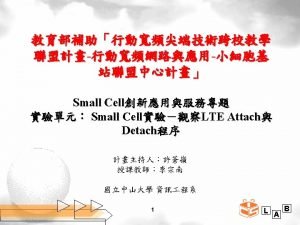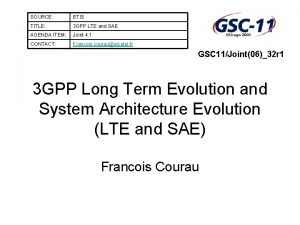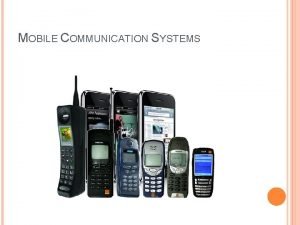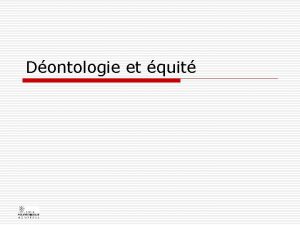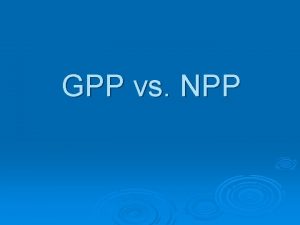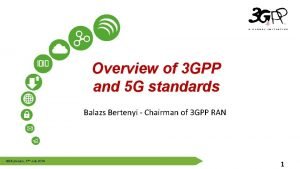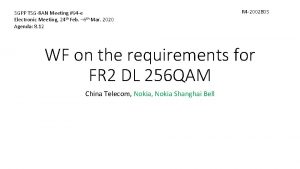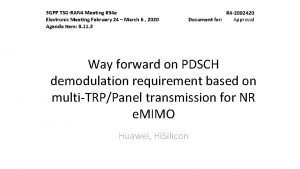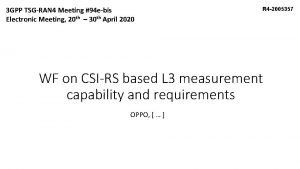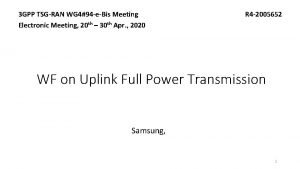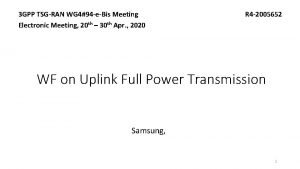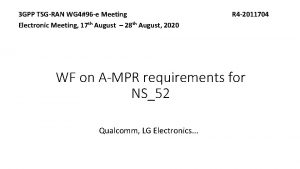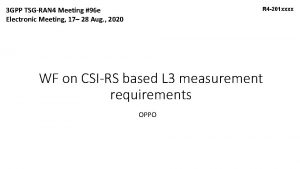3 GPP TSGRAN 4 Meeting 96 e Electronic









- Slides: 9

3 GPP TSG-RAN 4 Meeting #96 -e Electronic Meeting, 17 - 28 Aug, 2020 Agenda item: 7. 16. 1. 4 R 4 -2012691 Way forward on UE power imbalance requirements for FR 1 CA and EN-DC NTT DOCOMO

Background: WF in previous meeting • RAN 4 # 95 -e • WF: R 4 -2008848 2

Wayforward For FR 1 intra-band contiguous CA • Channel bandwidth combination for defining performance requirements • Define generic methodology for selection of CBW combination among all CBW combinations in supported CA configurations, and define bandwidth agnostic requirements. • Channel bandwidth combination for testing • As baseline, use the following approach • Step 1: First select the CBW combinations with the same BWs in each carrier • • If there is no such CBW combination, select the CBW combinations with smallest CBW difference between the two carriers, and the carrier with smaller CBW will be used for test. Step 2: Among the CBW combinations selected from step 1, select the CA combination with largest aggregated CBW 3

Wayforward For FR 1 intra-band contiguous CA • PDSCH RB allocation • Full RB allocation • MCS • Modulation order: 64 QAM for 2 Rx and 4 Rx • MCS • • Option 1: MCS 27 for 2 Rx, MCS 28 for 4 Rx Option 2: MCS 25 for 2 Rx • Applicability rule • Option 1: Reuse the following applicability rule from LTE CA power imbalance test • • For FDD or TDD CA power imbalance tests, if they are tested with FDD or TDD intra-band contiguous CA configurations with 2 DL CCs, the test coverage can be considered fulfilled with FDD or TDD intra-band contiguous CA configurations with 3 or more DL CCs supported by the UE. For FDD or TDD 2 DL CCs, only test the supported intra-band contiguous CA configurations covering the lowest and highest operating bands. • Other options are not precluded. 4

Wayforward For intra-band contiguous and non-contiguous EN-DC • Tested carrier • Allocate the test RBs on NR carrier • Channel bandwidth combination for defining performance requirements • Reuse the agreement from FR 1 intra-band contiguous CA • Define generic methodology for selection of CBW combination among all CBW combinations in supported EN-DC configurations, and define bandwidth agnostic requirements. • SCS (TDD) • Option 1: 30 k. Hz • Option 2: 15 k. Hz and 30 k. Hz • Test #2 b: LTE TDD + NR TDD 30 k. Hz, in case UE supports it, otherwise LTE TDD + NR TDD 15 k. Hz • TDD pattern for 15 k. Hz SCS (if needed) • Option 1: DSU+DD • Option 2: DDDSU • Option 3: Not need 5

Wayforward For intra-band contiguous and non-contiguous EN-DC • RAN 4 uses the following test parameters if no technical issues will be figured out. Parameters Value Reference testing point 85% of maximum throughput PDSCH DMRS configurations DMRS type: Type 1 Number of additional DMRS: 1 (i. e. , 1+1) Transmission rank Rank 1 MCS Same value as FR 1 intra-band contiguous NR CA Max number of HARQ transmission 1 (RV = {0}) Precoding configuration SP Type I, Random per slot with PRB bundling granularity PRB bundling size WB • For the other test parameters and applicability rules, if not explicitly discussed, reuse the same agreements from CA power imbalance test. 6

Wayforward For intra-band contiguous EN-DC and non-contiguous EN-DC • Channel bandwidth combination for testing • Option 1 • Step 1: First select the CBW combinations with the same BWs in each carrier • • Step 2: Among the CBW combinations selected from step 1, select the CBW combinations where the NR carrier has smaller CBW than the LTE carrier; if no such CBW combination, directly go to step 3. Step 3: Among the CBW combinations selected from step 2, select the EN-DC combination with largest aggregated CBW • Step 1: First select the CBW combinations with the same BWs between LTE carrier (single carrier or aggregated carriers) and NR carrier • If there is no such CBW combination, select the CBW combinations with smallest CBW difference between the two carriers. • Option 2 • If there is no such CBW combination, select the CBW combinations with smallest CBW difference between the two carriers. • If frequency range of NR carrier is higher than LTE carrier, then the test RBs will be allocated on the highest part of NR carrier. • If frequency range of NR carrier is lower than LTE carrier, then the test RBs will be allocated on the lowest part of NR carrier. • Step 2: Among the CBW combinations selected from step 1, select the EN-DC combination with largest aggregated CBW. • Step 1: First select the CBW combinations with the same BWs in each carrier. If there is no such CBW combination, go to Step 1 a and Step 1 b, otherwise Step 2. • Option 3 • • Step 1 a: Select the CBW combinations that the BW of NR carrier is smaller than the BW of LTE carrier Step 1 b: Among the CBW combinations selected from Step 1 a, select the CBW combinations with the smallest CBW difference between the two carriers • Step 2: Among the CBW combinations selected from Step 1, select the EN-DC combination with the largest aggregated CBW • Step 1: First select the CBW combinations with the same BWs between LTE carrier (single carrier or aggregated contiguous carriers) and NR carrier. If there is no such CBW combination, go to Step 1 a, Step 1 b and Step 1 c. • Option 4 • • Step 1 a: Select the CBW combinations that the BW of NR carrier is smaller than the (aggregated) BW of LTE carrier(s). If there is no such CBW combination, go to Step 1 c. Step 1 b: Among the CBW combinations selected from Step 1 a, select the CBW combinations with the smallest CBW difference between NR carrier and LTE carrier(s) Step 1 c: select the EN-DC combinations with smallest CBW difference between the NR carrier and LTE carrier(s). Step 2: Among the CBW combinations selected from Step 1, select the EN-DC combination with the largest aggregated CBW • Other options are not precluded. 7

Wayforward For intra-band contiguous and non-contiguous EN-DC • Channel bandwidth combination for testing • Whether to consider the aggregated contiguous carriers for LTE if UE supports it? • • Option 1: Consider the aggregated contiguous carriers for LTE Option 2: Do not consider the aggregated contiguous carriers for LTE • Whether to test partial PRB or full PRB for NR carrier, in case the CBW is different in LTE carrier(s) and NR carrier? • • Option 1: Partial PRB Option 2: Full PRB • LO position • Option 1: “LO in middle” (1 st priority) • Option 2: “LO in middle” and “LO at edge of one CC” (2 nd priority) • • FFS: Channel bandwidth combination for testing FFS: whether some limitations on frequency separation between two CCs should be included in applicability rule for noncontiguous EN-DC 8

Wayforward For intra-band non-contiguous EN-DC • Test applicability rules • Option 1 • UE supports only intra-band contiguous EN-DC, i, e. , if UE does not indicate “intra. Band. ENDC-Support”, • • UE supports only intra-band non-contiguous EN-DC, i. e. , if UE indicates “non-contiguous” in “intra. Band. ENDC-Support” or UE does not indicate “inter. Band. Contiguous. MRDC”, • • power imbalance requirement for intra-band contiguous EN-DC is applied power imbalance requirement for intra-band non-contiguous EN-DC is applied UE supports both intra-band contiguous and non-contiguous EN-DC, i. e. , if UE indicates “both” in “intra. Band. ENDC-Support” or UE indicates “inter. Band. Contiguous. MRDC”, • power imbalance requirement for FR 1 intra-band contiguous EN-DC • Option 2 • UE supports only intra-band contiguous EN-DC, i, e. , if UE does not indicate “intra. Band. ENDC-Support”, • • UE supports only intra-band non-contiguous EN-DC, i. e. , if UE indicates “non-contiguous” in “intra. Band. ENDC-Support” • • power imbalance requirement for intra-band contiguous EN-DC is applied power imbalance requirement for intra-band non-contiguous EN-DC is applied UE supports both intra-band contiguous and non-contiguous EN-DC, i. e. , if UE indicates “both” in “intra. Band. ENDC-Support” • power imbalance requirement for FR 1 intra-band contiguous EN-DC 9
